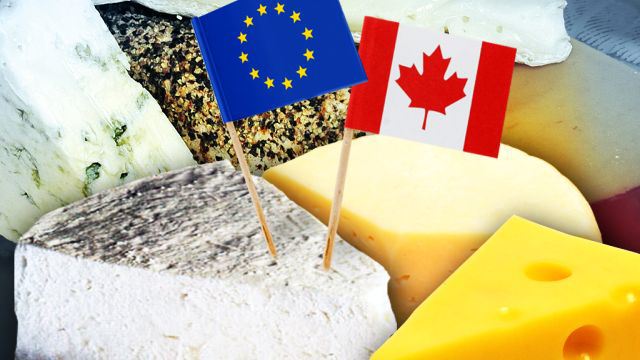US dairy industry decries market barriers raised in EU-Canada trade deal

International Dairy Foods Association (corporate press release) | 29.09.2014
US dairy industry decries market barriers raised in EU-Canada trade deal
Geographical indications, reallocated cheese quotas would restrict US access to Canadian markets
WASHINGTON, Sept. 29, 2014 /PRNewswire-USNewswire/ — The text of the European Union-Canada Comprehensive Economic and Trade Agreement (CETA) released at the end of last week contains provisions on geographical indications (GIs) and reallocates a portion of the World Trade Organization tariff rate quota for cheese to the EU. The U.S. dairy industry expressed concern today that these provisions would raise artificial trade barriers restricting market access for American cheeses to the Canadian market. In addition, CETA provides very limited access to many EU dairy products as a result of the agreement’s prioritization of the GI goals of a few "squeaky wheels," at the expense of broader gains across the full EU dairy industry, according to U.S. dairy industry trade groups.
The provisions on geographical indications are particularly alarming because they grant automatic protection to the EU for "asiago," "feta," "fontina," "gorgonzola" and "munster" in complete disregard of Canadian intellectual property laws. Cheese manufacturers that produced those cheeses prior to October 18, 2013, will be allowed to continue to use those names, but future producers of those cheeses will have to add qualifiers, such as "kind," "type," "style" and "imitation." These new limitations on the use of generic names clearly violate Canadian intellectual property procedures and existing international trade commitments.
"The automatic protection for five cheese names that are generic in Canada, the U.S. and globally is another example of the EU’s overreach on geographical indications," said Clay Hough, senior group vice president of the International Dairy Foods Association (IDFA). "The EU’s GI strategy is incompatible with the fundamental goal of a trade negotiation, which is to remove trade barriers—not add them—and allow for greater competition."
As part of the agreement, Canada also reallocated 800 metric tons of its 20,412 metric ton WTO tariff rate quota for cheese to the EU. This reallocation further restricts the limited access that U.S. cheese exporters have into the Canadian market.
"Canada added insult to injury by not only impairing the quality of the cheese market access U.S. exporters expect to gain through ongoing Trans-Pacific Partnership negotiations, but also moving to water down the small access they currently offer to U.S. exporters through Canada’s WTO quota," said Jaime Castaneda, senior vice president for the National Milk Producers Federation (NMPF) and the U.S. Dairy Export Council (USDEC). "This is yet another example of Canada’s work at every turn to limit access into its market for highly competitive U.S. products."
The text is not yet binding and still requires a legal review and ratification. The date of full implementation of the agreement is unknown at this point.
The International Dairy Foods Association (IDFA), Washington, D.C, represents the nation’s dairy manufacturing and marketing industries and their suppliers, with a membership of 550 companies within a $125-billion a year industry. IDFA is composed of three constituent organizations: the Milk Industry Foundation (MIF), the National Cheese Institute (NCI) and the International Ice Cream Association (IICA). IDFA’s nearly 200 dairy processing members run nearly 600 plant operations, and range from large multi-national organizations to single-plant companies. Together they represent more than 85 percent of the milk, cultured products, cheese, ice cream and frozen desserts produced and marketed in the United States.
The U.S. Dairy Export Council (USDEC) is a non-profit, independent membership organization that represents the global trade interests of U.S. dairy producers, proprietary processors and cooperatives, ingredient suppliers and export traders. Its mission is to enhance U.S. global competitiveness and assist the U.S. industry to increase its global dairy ingredient sales and exports of U.S. dairy products. USDEC accomplishes this through programs in market development that build global demand for U.S. dairy products, resolve market access barriers and advance industry trade policy goals. USDEC is supported by staff across the United States and overseas in Mexico, South America, Asia, Middle East and Europe.
The National Milk Producers Federation (NMPF), based in Arlington, Va., develops and carries out policies that advance the well-being of U.S. dairy producers and the cooperatives they collectively own. The members of NMPF’s cooperatives produce the majority of the U.S, milk supply, making NMPF the voice of nearly 32,000 dairy producers on Capitol Hill and with government agencies. For more on NMPF’s activities, visit www.nmpf.org.





